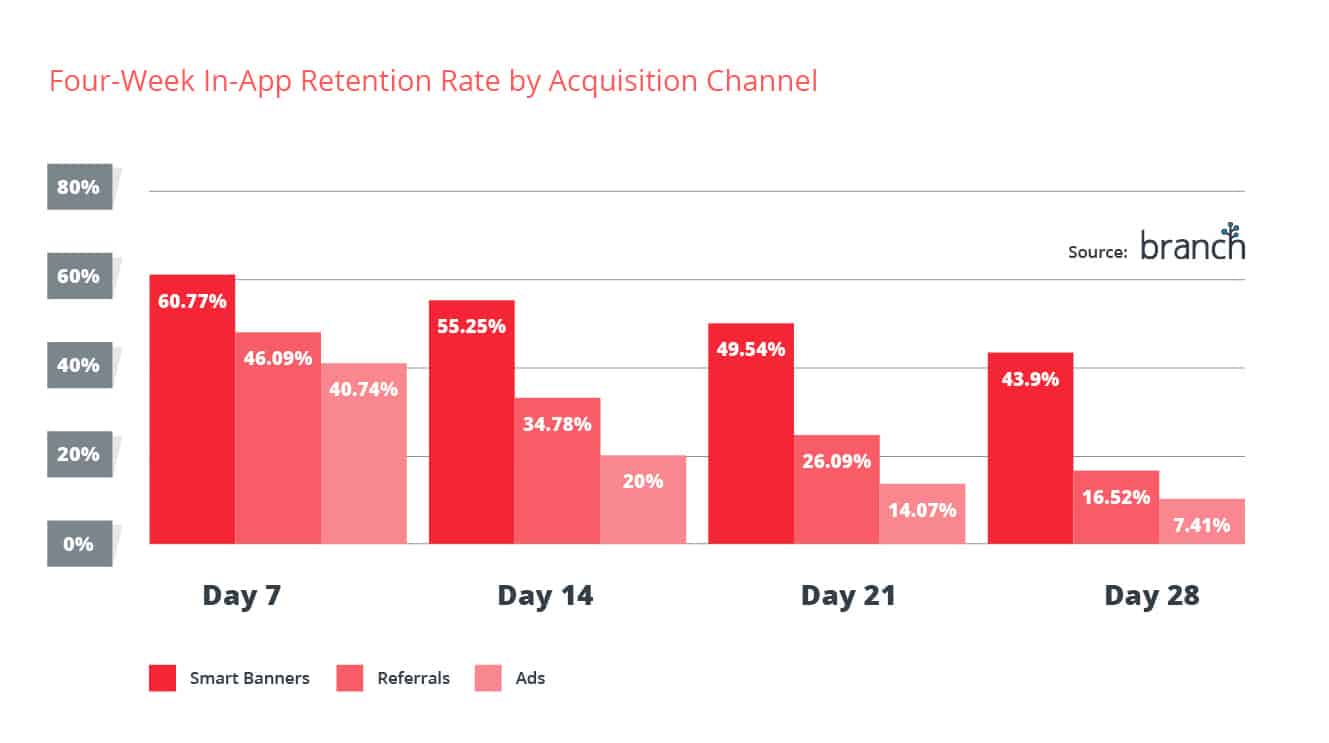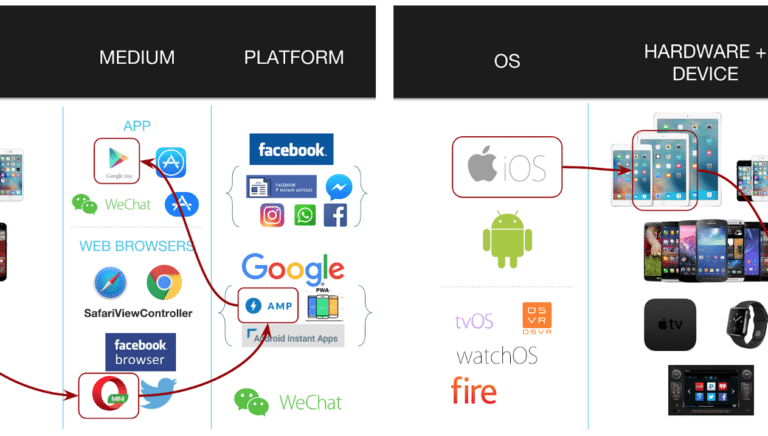I was recently at Web Summit in Lisbon talking about mobile growth with startups just gaining momentum, as well as big brands like Burberry and L’Oreal.
Along the way, one thing hit me: When the term mobile growth is used, it’s often in specific reference to growing the adoption and usage of mobile apps. So when I gave my talk about Branch’s 2018 Mobile Growth Handbook, one thing was certain: I had to change that mindset, because the future of mobile growth is cross-platform.
What is Cross-Platform in the context of mobile?
Over the past few years mobile has evolved extensively. Mobile used to mean just your phone, and then it became your smartphone that had a mini computer in it, and the apps in your car, your watch, your tablet, your VR set. As mobile started becoming more and more fragmented, so have user journeys and brand interactions. As we think of the mobile market today, cross-platform can mean many things – it can be as limited as different devices or as broad as different social platforms like Facebook, or WeChat.
To me, a platform is where users can interact with multiple brands and perform an assortment of functions within a cohesive environment. Because they allow users to access wide variety of content and accomplish many tasks from a single login, platforms create network effects that can benefit both users and brands. For example, Facebook can be a promotion channel because it enables developers to build an app on it, and it has a browser that enables users to access web content and make purchases without leaving the platform. In fact, platforms can take many different shapes and sizes, as can customer journeys to your content and product. For example:

Why Cross-Platform?
There are many questions worth asking: Should you build a website or an app? Should you sell on Amazon or your own platform? Should they have a website or just a Facebook page?
Unfortunately, in today’s world, platforms behave like empires: They will do everything in their power to keep a user’s attention, and prevent them from leaving their platform’s walled garden. That means that they will let you exist and create experiences for your users and customers inside their ecosystem, but only if you follow their rules, which in some cases give them full ownership of user data and information.
Users on the other hand are fickle – they like to use multiple platforms, browse the web, download apps, have multiple devices at work and at home. Their interactions with a brand are no longer linear or single-platform. They might see something on a Facebook page, browse on the website and purchase in an app – I know that’s my behavior many times. Sometimes, I look at something on my computer and buy on my phone or the other way around.
So if, as a brand, you create mobile experiences that are linear, and that don’t take into account this complicated journey and you don’t measure cross-platform, then you are losing your audience’s attention and not measuring properly.
As you think about your company’s efforts cross-platform, there are three main points to consider:
1. Acquire and Convert Users Cross-Platform
Why: Some platforms like the web or social media platforms are much cheaper than others at acquiring users, while others like mobile apps are expensive to acquire users, but much better for engagement and conversion. Acquiring users organically or for lower marketing dollars on the web or social media and converting them and engaging them in a mobile app can result in a much higher overall ROI for your brand.
How/Results: At Branch, one of our most used and loved products, with many case studies is our Journeys web-to-app product. Journeys converts web users to app users, enabling marketers to acquire new users through SEO and organic, and subsequently raise user interest before converting them into the app via banners targeted at the right time with the right message and discount. And it works wonders.
By using web and app Journeys, The Knot achieved 35% app usage growth on iOS, 45% app usage growth on Android using Journeys. Additionally, the overall engagement of these cross-platform users increased 2X. OLX increased conversions 10x when they converted their web users into app users vs. just buying users from their DSP directly into their app.
2. Keep Context and Engage Cross-Platform
Why: If you’re thinking about your own buying experiences as a consumer, this should be obvious. How many times did you click a post on Facebook that had a beautiful dress displayed, you downloaded an app or went to their website and the dress was nowhere to be found? It happens to me weekly. When I talk about cross-platform experiences, I mean passing content through platforms – if someone was trying to book a ticket on your website, show them that ticket when they open the mobile app. In addition, data shows that app users sourced from cross-platform channels like sharing or web banners engage and retain longer.

How/Results: Some of the biggest issues with cross-platform experiences are the ability to take users from one platform to another and still keep the context. This context is incredibly important because losing context sometimes means losing the intent and the user all together. Some ways to keep context:
- Improve click to open rates – this seems like a given because in the days of the web this wasn’t really an issue. But when customer journeys become fragmented, many users struggled to connect with content – especially when it involved a mobile app. Fortunately, more sophisticated linking technology has emerged and those times have largely passed. For example, Checkout 51 did a study of their links and found that creating better mobile linking improved their click to open rates from 50% to 93%.
- Keep context through deep linking, deferred deep linking and personalization – Deep linking by definition is about keeping context across platforms, and it works. Rent the Runway used deep linking from email into the app and increased the conversion to purchase from email by 200%. Addison Lee used contextual data to personalize their app onboarding, getting 3X faster onboarding with 95% completion rate vs. the industry standard that is 50%.
3. Measure Cross-Platform
Why: As you think of the complicated acquisition journeys, it’s incredibly important to understand all facets of the user journey and make sure that when you think of attribution you think of attribution that works reliably on every platform – not just cookies or IDFAs that only work on one platform.
How/Results: At Branch, we achieve this through a link graph that understands a user across devices, browsers, and web + app so we can give you holistic attribution results. We built this graph through our 6 billion links that link billions of users every day through content from both paid and organic campaigns across all platforms. Most legacy attribution providers built companies catering to games that acquired users through app install ads and had simpler user journeys. These same companies have struggled to live in a cross-platform world where campaigns are no longer just around app attribution, but a holistic customer journey. Top mobile brands that do side-by-side comparisons on matching before acquiring a solution pick Branch not just because of the ease of use and product features, but because of our cross-platform capabilities that extend to both their paid and organic campaigns.
Companies that use cross-platform attribution to measure their efforts found between 25% (Nextdoor) and 30% (Tokoepdia) of their transactions were previously misattributed.
Looking Ahead
As you think about the latest trends in mobile, one thing is certain: Platform fragmentation is not getting better. A future in which apps rule and the web is forgotten, or where all apps become progressive web apps is not a feasible future. Social platforms like WeChat and Facebook and continue to build larger and more closed ecosystems, while users browse, shop, and engage across an increasing multitude of platforms. To grow, flourish and keep ahead in mobile you need to think, build promote and measure cross-platform, and Branch can help.
To view my Web Summit session, Inside the Mobile Marketing Growth Handbook, click here. And if you want to find out how Branch can help you master cross-platform experiences, contact our Sales team for more information.






















